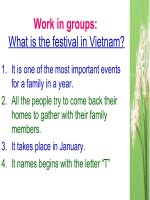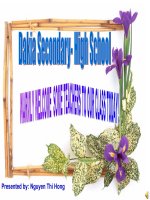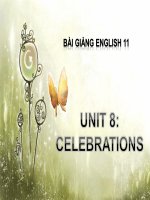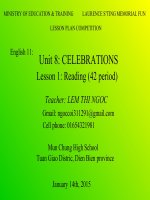Unit 8 Celebrations Reading English 11
Bạn đang xem bản rút gọn của tài liệu. Xem và tải ngay bản đầy đủ của tài liệu tại đây (3.41 MB, 31 trang )
<span class='text_page_counter'>(1)</span>Presented by: Hoang Thi Thien Thai.
<span class='text_page_counter'>(2)</span> 1 2. 3 5. 1/ What time of the year is it? 2/ What are the people in the picture doing? 3/ What else do you see in the picture?. 4.
<span class='text_page_counter'>(3)</span> UNIT 8: CELEBRATIONS.
<span class='text_page_counter'>(4)</span> making Banh Chung. decorating the house. eating special Tet foods. going to the flower market. going to the pagoda. watching fireworks. receiving “lucky money”. visiting relatives & friends.
<span class='text_page_counter'>(5)</span> UNIT 8: CELEBRATIONS- LESSON 1: READING New words: Agrarian people(n) = farmers:. Người nông dân.
<span class='text_page_counter'>(6)</span> UNIT 8: CELEBRATIONS- LESSON 1: READING New words:. Apricot blossom. Peach blossom. /'eiprikɔt 'bl ɔsəm/. /pi:t∫'bl ɔsəm/.
<span class='text_page_counter'>(7)</span> UNIT 8: CELEBRATIONS- LESSON 1: READING New words:. Candied fruit. Kumquat tree.
<span class='text_page_counter'>(8)</span> UNIT 8: CELEBRATIONS- LESSON 1: READING New words: - spread- spread- spread (v): - positive comments (n):. trải dài, kéo dài. những lời tốt đẹp. /'pɔzətiv 'kɔments /. Ex: Only positive comments should be made on the days of Tet.. - lucky money (n): Tiền lì xì.
<span class='text_page_counter'>(9)</span> UNIT 8: CELEBRATIONS- LESSON 1: READING New words: 1/ Agrarian people (n) người nông dân 2/ Apricot blossom /'eiprikɔt 'bl ɔsəm/ (n): Hoa mai 3/ Peach blossom /pi:t∫'bl ɔsəm/ (n): Hoa đào 4/ Kumquat tree / 'kʌmkwɔt tri:/ (n): Cây quất 5/ Candied fruit /'kændid fru:t/ (n): 6/ Positive comments /'pɔzətiv 'kɔments/ (n): 7/ Spread- spread- spread (v): Trải dài, kéo dài 8/ lucky money (n) Tiền lì xì.
<span class='text_page_counter'>(10)</span> UNIT 8: CELEBRATIONS- LESSON 1: READING. Read the text about Tet in Vietnam. Lunar New Year, or Tet, is Vietnam’ s main holiday. It is the grandest and most important occasion in the year which falls sometimes between 19th January and 20th February on the Western calendar. Tet marks the beginning of spring and, for agrarian people, the start of a new year. Tet’s preparations and celebrations used to be spread over months, but nowadays the holiday is much shorter. A great deal of excitement still builds up well before Tet, however. Streets are decorated with coloured lights and red banners. Shops are full of goods. People are busy buying gifts, cleaning and decorating their houses and cooking traditional.
<span class='text_page_counter'>(11)</span> UNIT 8: CELEBRATIONS- LESSON 1: READING Homes are often decorated with plants and flowers at this time. Peach blossom is traditional at Tet in the North while apricot blossom is traditional in the South. The kumquat tree with its ripe deep orange fruits is popular throughout the country. One of Tet’s most special foods is banh chung, which is made from sticky rice, green beans and fatty pork. Mut, which is candied fruit such as sugared apples, plums or tomatoes, is also popular. On the days of Tet everyone tries to be nice and polite to each other. People believe that what they do on the first day of the year will influence their luck during the whole year. Thus, only positive comments should be made. People visit other family members or friends, and they exchange New Year’s wishes. Children receive their “lucky money” inside red envelopes. Many people go to the pagoda to pray for a happy year for themselves and their family. Both children and adults take part in games and various forms of entertainment. Tet is really a time of fun and festivals throughout the country.
<span class='text_page_counter'>(12)</span> UNIT 8: CELEBRATIONS- LESSON 1: READING. Task 1: Guess the meaning of the red and bold words in the following sentences: 1. Tet holiday in Viet Nam is the grandest and most important occasion trọng đại, to lớn, hoành tráng in the year. 2. For agrarian people, Tet marks the start of a new year. thuéc vÒ nghÒ n«ng 3. Streets are decorated with coloured lights and red banners. b¨ng r«n, khÈu hiÖu 4. Many people go to the pagoda to pray for a happy year. cÇu nguyÖn 5. Mut, which is candied fruit such as sugared apples, plums or møt t¸o tomatoes, is also popular. 6. A great deal of excitement still builds up well before Tet. sù n« nøc.
<span class='text_page_counter'>(13)</span> UNIT 8: CELEBRATIONS- LESSON 1: READING TASK2: (Page 92): Read the text again, and then decide whether the statements are true (T) or false (F). T F. 1. Tet is always sometimes onbetween 20th February 19th January on the and Western 20th February. calendar.. . According to the text, for people anywhere agrarian people in the world. . the beginning of spring is the start of a new year. Tet used to be longer than it is nowadays.. . 4. According to the text, “lucky money” is given to. . children everyone at Tet. Kumquat trees are popular both in the North and in the South of Vietnam 6. People try to be nice and polite to each other because they during wholeDay. year. want to have good luck on Newthe Year’s. .
<span class='text_page_counter'>(14)</span> UNIT 8: CELEBRATIONS- LESSON 1: READING Task 3 (page 92): Answer the following questions.. 1/ When is Tet holiday in Vietnam? 2/ How long did Tet preparations and celebrations last in the past? 3/ What do streets look like before Tet? 4/ What do people often do to prepare for Tet? 5/ What is banh chung made from? 6/ What is mut? 7/ What are some popular activities at Tet ?.
<span class='text_page_counter'>(15)</span> UNIT 8: CELEBRATIONS- LESSON 1: READING Task 3 (page 92): Answer the following questions.. Question 1: When is Tet holiday in Vietnam? It’s sometimes between 19th January and 20th February ..
<span class='text_page_counter'>(16)</span> UNIT 8: CELEBRATIONS- LESSON 1: READING Task 3 (page 92): Answer the following questions.. Question 2: How long did Tet preparations and celebrations last in the past?. It lasted for months.
<span class='text_page_counter'>(17)</span> UNIT 8: CELEBRATIONS- LESSON 1: READING Task 3 (page 92): Answer the following questions.. Question 3: What do streets look like before Tet? They are decorated with coloured lights and red banners..
<span class='text_page_counter'>(18)</span> UNIT 8: CELEBRATIONS- LESSON 1: READING Task 3 (page 92): Answer the following questions.. Question 4: What do people often do to prepare for Tet? They buy gifts , clean and decorate their houses and cook traditional foods..
<span class='text_page_counter'>(19)</span> UNIT 8: CELEBRATIONS- LESSON 1: READING Task 3 (page 92): Answer the following questions.. Question 5: What is banh chung made from? It is made from sticky rice, green bean and fatty pork..
<span class='text_page_counter'>(20)</span> UNIT 8: CELEBRATIONS- LESSON 1: READING Task 3 (page 92): Answer the following questions.. Question 6: What is mut? Mut is candied fruit such as sugared apples, plums or tomatoes..
<span class='text_page_counter'>(21)</span> UNIT 8: CELEBRATIONS- LESSON 1: READING Task 3 (page 92): Answer the following questions. Question 7: What are some popular activities at Tet ? Some popular activities at Tet are: - visiting other family members or friends and exchanging wishes, - going to the pagoda, - playing games…...
<span class='text_page_counter'>(22)</span> UNIT 8: CELEBRATIONS- LESSON 1: READING Task 4: Read the passage and choose the best answer for each blank. 1/ 2/ 3/ 4/ 5/ 6/. On the days of Tet everyone tries to be nice and (1).............to each other. People believe that what they do on the first day of the year will (2)........ their luck during the whole year. Thus, only positive (3)............ should be made. People visit other family members or friends, and they exchange New Year’s wishes. Children receive their (4) “.........................” inside red envelopes. Many people go to the pagoda to (5)............for a happy year for themselves and their family. Both children and adults take part (6).......... games and various forms of entertainment. Tet is really a time of fun and festivals throughout the country a. a.polite polite b. impolite c. politeness d. politely a. be influenced b. influencing c. influence d. to influence influence a. comments b. ideas c. opinions d. thoughts a.comments b. lucky lucky money a. cards b. money c. gifts d. presents d. pray pray a. prayed b. to pray c. praying d. a. at b. with c. d. for c. in in.
<span class='text_page_counter'>(23)</span> In groups, tell each other about your last Tet holiday. How you prepared (cleaned the house , decorated the house …). Last Tet holiday Last Tet holiday, we……….. Who you visited (relatives, teachers, friends… ) What special foods you ate (banh chung, candied fruit…) What activities you enjoyed most (receiving lucky money, going to the flower market… ).
<span class='text_page_counter'>(24)</span> Homework:. -Study by heart all the new words.. -Reread the text and practise answering all the questions. -Write a small talk about your last Tet holiday.. - Prepare for Speaking..
<span class='text_page_counter'>(25)</span>
<span class='text_page_counter'>(26)</span> to our class Presented by: Hoang Thi Thien Thai.
<span class='text_page_counter'>(27)</span> UNIT 8: CELEBRATIONS- LESSON 1: READING Task 1: Find what the following words mean in the text. to lớn, hoành tráng 1. grand(a): ___________________. cầu nguyện 4. pray (v) ________________. thuộc về nông nghiệp 2. agrarian (a): _________________. mứt táo 5.sugared apples (n) :__________. băng rôn, khẩu 3. banner (n): __________________ hiệu. náo nức, nhộn nhịp 6. excitement (n)sự_____________.
<span class='text_page_counter'>(28)</span> Apricot blossom. Kumquat tree. candied fruit. Peach blossom.
<span class='text_page_counter'>(29)</span> Homework: - Study by heart all the new words. - Reread the text and practise answering all the questions. - Prepare for Speaking..
<span class='text_page_counter'>(30)</span> UNIT 8: CELEBRATIONS- LESSON 1: READING Check-up: Match the word in column A with their Vietnamese meaning in column B. A 1. grand 2. agrarian 3. banner 4. pray 5. sugared apples 6. excitement. B a.mứt táo b.to lớn c.băng rôn, khẩu hiệu d. sự náo nức, nhộn nhịp e. cầu nguyện f. thuộc về nông nghiệp.
<span class='text_page_counter'>(31)</span> Thank you for your attention!.
<span class='text_page_counter'>(32)</span>









